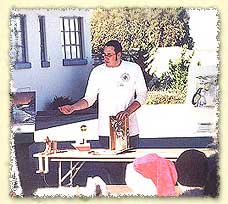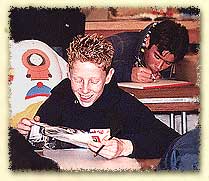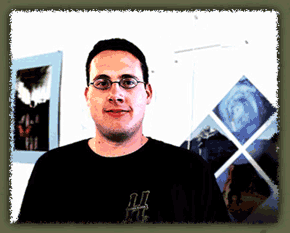| Shannon
Harvey, RUAP Community Liaison, interviewed Shane Mahon:
|
SH:
What drew you to CSUMB and VPA in particular?
SM: It was all about public art. I had some opportunities to go to (traditional)
art school, but I liked the idea of social involvement. It was also relatively
inexpensive, and I could save money for graduate school. |
SH:
What is your impression of the VPA Major Pro Seminar Class?
SM: It was a lot of work, a lot of paper writing, but also a lot of real
world work like working with RUAP to get funding, (to planning committees).
Some of that was no fun. But it was a really good learning experience
and now that I'm done I think that was a hundred percent great, because
that's what I need to know. Working with people was another tricky one.
Being collaborative is a whole different mindset. |
SH:
Talk a little about the process of planning High School Art Day and how
that went.
SM: It was difficult because none of us were experienced working within
committees. We had a lot of problems because we broke up into groups early
and we didn't have any sense of an overall vision. We tried to fit these
different ideas together. Eventually it worked out really well and when
the kids came we had a great day. |
SH:
Could you tell me a little about the projects your class came up with
for the high school students?
 SM:
There were two projects. One was 2-dimensional and one was 3-dimensional.
The 2-dimensional project was a self-portrait or a narrative story about
yourself or your family. The 3-dimensional project was a portrait of your
community or a larger segment of society. We used pastels and pencils.
We had given them sketchbooks to use for the 2-dimensional (project) and
that worked well. We also made a diorama with boxes that one VPA student
had collected and they worked great. We went to Last Chance (a thrift
shop) and got a lot of junk: little dinosaurs, keys, and toy sharks, and
other found objects. We had a big pile of these and we said "take one
or two of these" and that really helped motivate people, they saw something
right away. We had wire and a lot of students responded to making sculpture
out of the wire. People also responded well to hanging things in the boxes,
taping things. We had made examples that I think were helpful. But most
of the kids took off and did their own thing. Having a lot of magazines
from Last Chance was really important. SM:
There were two projects. One was 2-dimensional and one was 3-dimensional.
The 2-dimensional project was a self-portrait or a narrative story about
yourself or your family. The 3-dimensional project was a portrait of your
community or a larger segment of society. We used pastels and pencils.
We had given them sketchbooks to use for the 2-dimensional (project) and
that worked well. We also made a diorama with boxes that one VPA student
had collected and they worked great. We went to Last Chance (a thrift
shop) and got a lot of junk: little dinosaurs, keys, and toy sharks, and
other found objects. We had a big pile of these and we said "take one
or two of these" and that really helped motivate people, they saw something
right away. We had wire and a lot of students responded to making sculpture
out of the wire. People also responded well to hanging things in the boxes,
taping things. We had made examples that I think were helpful. But most
of the kids took off and did their own thing. Having a lot of magazines
from Last Chance was really important.
|
SH:
Do you think some of the students had a hard time expressing very personal
things about themselves or their families?
 SM:
Some of them not at all. There may have been different levels of conscious
struggle with what they were producing. This one kid in particular did
this tiger that was bound. It was this really incredible image and I don't
know if he meant it that way. He used a grabber (an object with a pincher
at one end used to pick up things) that we had found at Last Chance. This
grabber had the shape of a tiger's head and he had cut a place in the
box and put the head on the box and then gave the box arms and legs and
a tail and then wrapped the whole thing with rope. It was so incredible.
I'm not sure if he was really conscious of what he was doing, but it was
a really powerful idea. Another student had taken a really graphic image
from national geographic of people covered in blood and he arranged it
just beautifully. He created this collage of unrelated images from different
magazines, but he fit them into the whole composition and they looked
like they were all together. So he had responded to the medium really
well. SM:
Some of them not at all. There may have been different levels of conscious
struggle with what they were producing. This one kid in particular did
this tiger that was bound. It was this really incredible image and I don't
know if he meant it that way. He used a grabber (an object with a pincher
at one end used to pick up things) that we had found at Last Chance. This
grabber had the shape of a tiger's head and he had cut a place in the
box and put the head on the box and then gave the box arms and legs and
a tail and then wrapped the whole thing with rope. It was so incredible.
I'm not sure if he was really conscious of what he was doing, but it was
a really powerful idea. Another student had taken a really graphic image
from national geographic of people covered in blood and he arranged it
just beautifully. He created this collage of unrelated images from different
magazines, but he fit them into the whole composition and they looked
like they were all together. So he had responded to the medium really
well. |
SH:
How was it to work with the high school students?
SM: It was really good. Most of the kids were well behaved, and the ones
that weren't were mostly just non-participatory. Some of them were really
into it, really grabbed the materials. |
SH:
What would you have done differently?
SM: The planning would be different. I would have everyone as a large
group first, talk about what we were going to do, then assign groups once
an overall plan has been made. We spent a lot of time doing nothing; this
group was waiting for another group to start while that group waited for
our group. I would have planned to do more art on the day itself; there
was a little bit of dead time at the end playing games. I think a lot
of people would have liked to have had fifteen more minutes on each of
the art projects and not had that free time at the end. Or I think that
free time should have been completely free time instead of trying to make
it games; we should have just let them do whatever. |
| SH:
How do you feel about becoming a visual and public artist? |
| SM:
I'm feeling better about it. My first semester was hard; I was taking
in a lot of new stuff. And it was a huge shift in thinking. I was used
to thinking of an artist as someone who works in their studio, creating
according to their own personal ideas, and maybe not really conscious
of having an audience. Here the emphasis is on working collaboratively
whether its with your fellow students or with members of a community in
order to create something meaningful to a lot of people, not just one
artist. |
"I
was used to thinking of an artist as someone who works in their studio,
creating according to their own personal ideas, and maybe not really conscious
of having an audience. Here the emphasis is on working collaboratively
whether its with your fellow students or with members of a community in
order to create something meaningful to a lot of people, not just one
artist." |
| I
could have gone to (traditional) art school and I came here and I was
really disappointed by the lack of studio time. That was the hardest thing
for me to get over. If I were in art school I would have hours of studio
time and here maybe 20% of the time you spend doing art. Major Pro Seminar
is a good example; there's no art making other than facilitating art making.
Now coming out of it and being done I see the importance and I'm glad
I did it. I understand the philosophy better and I'm excited about doing
it. I've always wanted to teach and I thought that this would be a good
addition to any teaching skills. I'm looking forward to working in the
public and maybe using it as a platform for community voice. It's an excellent
thing to learn. And even if I don't work as an artist, learning how to
collaborate with other people is going to be useful no matter what career
path I choose. |
 |




 SM:
There were two projects. One was 2-dimensional and one was 3-dimensional.
The 2-dimensional project was a self-portrait or a narrative story about
yourself or your family. The 3-dimensional project was a portrait of your
community or a larger segment of society. We used pastels and pencils.
We had given them sketchbooks to use for the 2-dimensional (project) and
that worked well. We also made a diorama with boxes that one VPA student
had collected and they worked great. We went to Last Chance (a thrift
shop) and got a lot of junk: little dinosaurs, keys, and toy sharks, and
other found objects. We had a big pile of these and we said "take one
or two of these" and that really helped motivate people, they saw something
right away. We had wire and a lot of students responded to making sculpture
out of the wire. People also responded well to hanging things in the boxes,
taping things. We had made examples that I think were helpful. But most
of the kids took off and did their own thing. Having a lot of magazines
from Last Chance was really important.
SM:
There were two projects. One was 2-dimensional and one was 3-dimensional.
The 2-dimensional project was a self-portrait or a narrative story about
yourself or your family. The 3-dimensional project was a portrait of your
community or a larger segment of society. We used pastels and pencils.
We had given them sketchbooks to use for the 2-dimensional (project) and
that worked well. We also made a diorama with boxes that one VPA student
had collected and they worked great. We went to Last Chance (a thrift
shop) and got a lot of junk: little dinosaurs, keys, and toy sharks, and
other found objects. We had a big pile of these and we said "take one
or two of these" and that really helped motivate people, they saw something
right away. We had wire and a lot of students responded to making sculpture
out of the wire. People also responded well to hanging things in the boxes,
taping things. We had made examples that I think were helpful. But most
of the kids took off and did their own thing. Having a lot of magazines
from Last Chance was really important.
 SM:
Some of them not at all. There may have been different levels of conscious
struggle with what they were producing. This one kid in particular did
this tiger that was bound. It was this really incredible image and I don't
know if he meant it that way. He used a grabber (an object with a pincher
at one end used to pick up things) that we had found at Last Chance. This
grabber had the shape of a tiger's head and he had cut a place in the
box and put the head on the box and then gave the box arms and legs and
a tail and then wrapped the whole thing with rope. It was so incredible.
I'm not sure if he was really conscious of what he was doing, but it was
a really powerful idea. Another student had taken a really graphic image
from national geographic of people covered in blood and he arranged it
just beautifully. He created this collage of unrelated images from different
magazines, but he fit them into the whole composition and they looked
like they were all together. So he had responded to the medium really
well.
SM:
Some of them not at all. There may have been different levels of conscious
struggle with what they were producing. This one kid in particular did
this tiger that was bound. It was this really incredible image and I don't
know if he meant it that way. He used a grabber (an object with a pincher
at one end used to pick up things) that we had found at Last Chance. This
grabber had the shape of a tiger's head and he had cut a place in the
box and put the head on the box and then gave the box arms and legs and
a tail and then wrapped the whole thing with rope. It was so incredible.
I'm not sure if he was really conscious of what he was doing, but it was
a really powerful idea. Another student had taken a really graphic image
from national geographic of people covered in blood and he arranged it
just beautifully. He created this collage of unrelated images from different
magazines, but he fit them into the whole composition and they looked
like they were all together. So he had responded to the medium really
well.